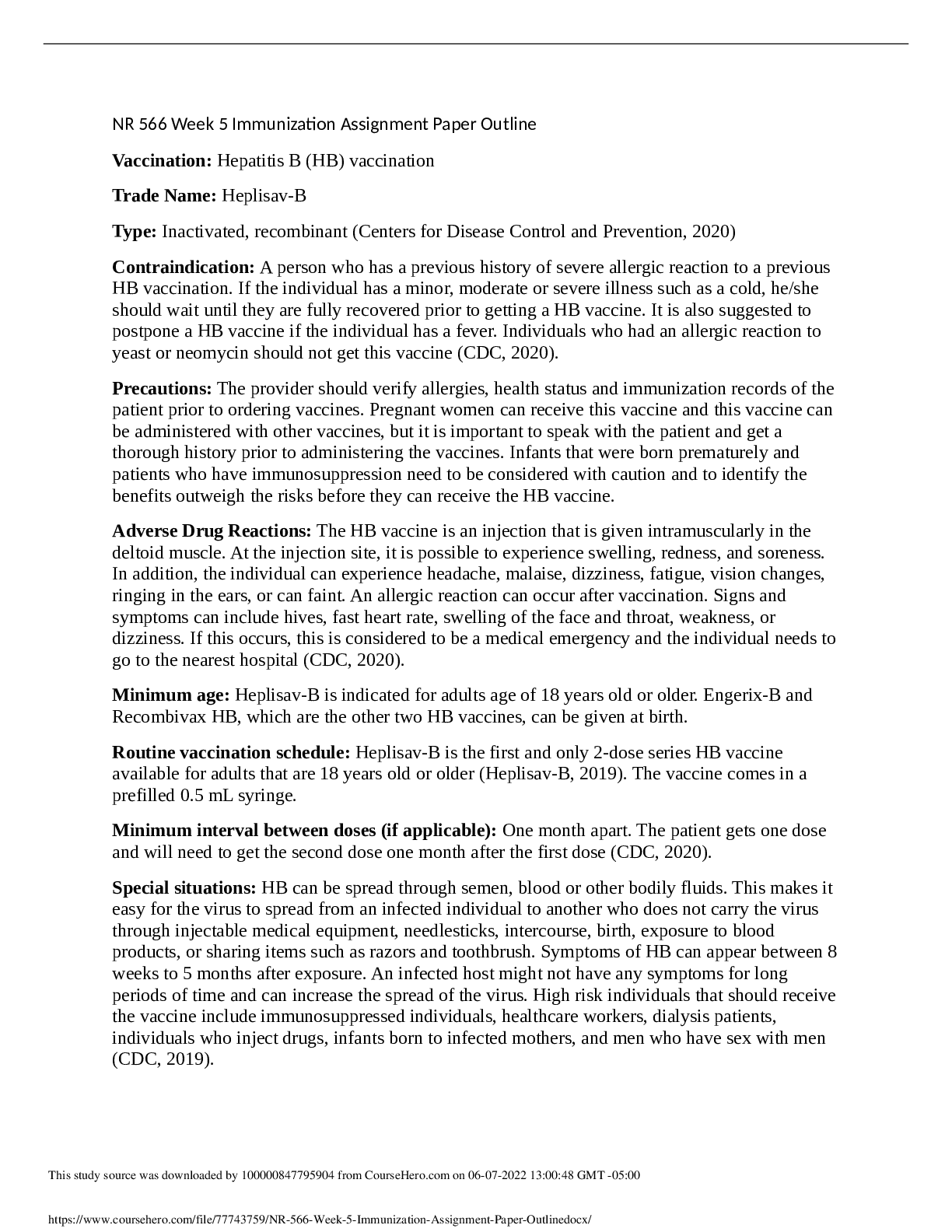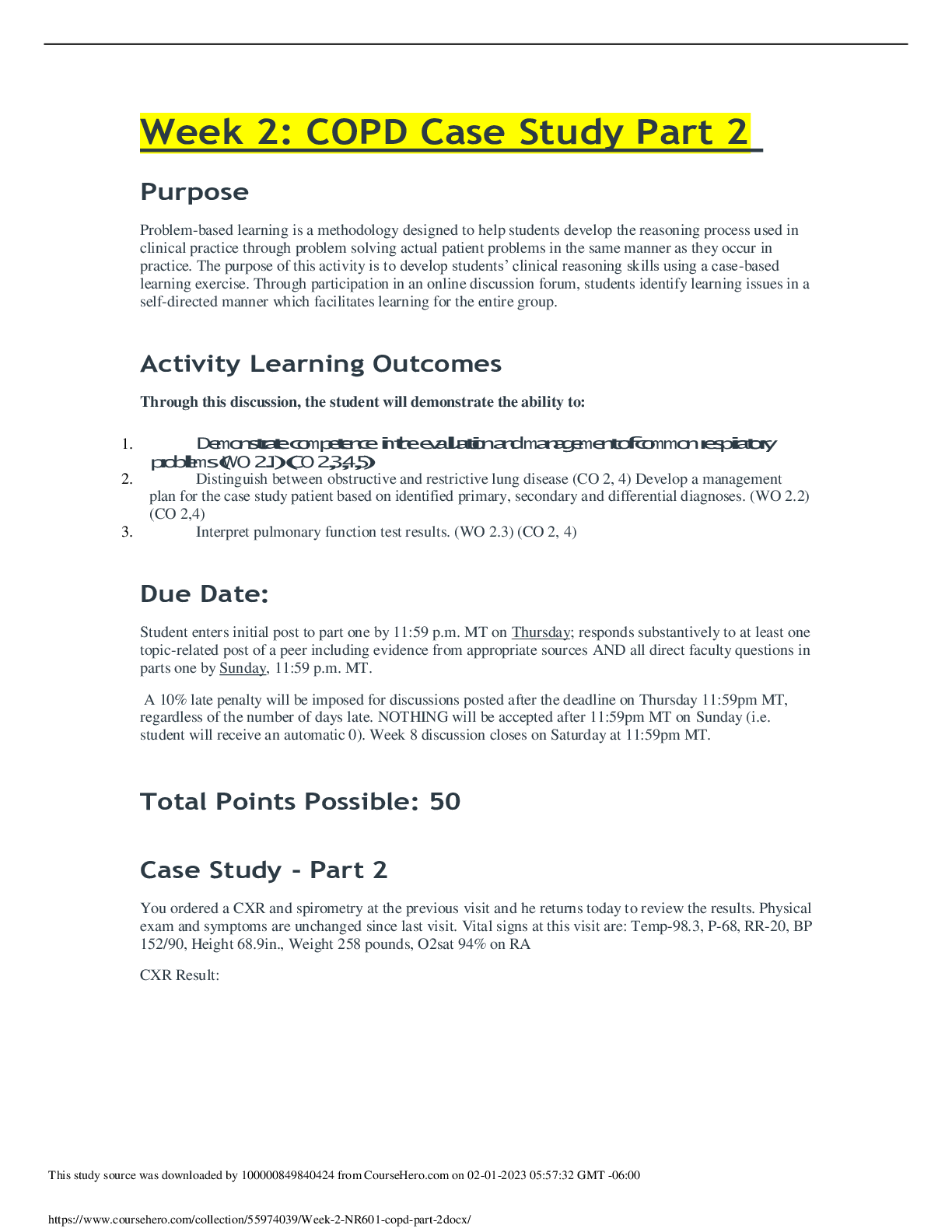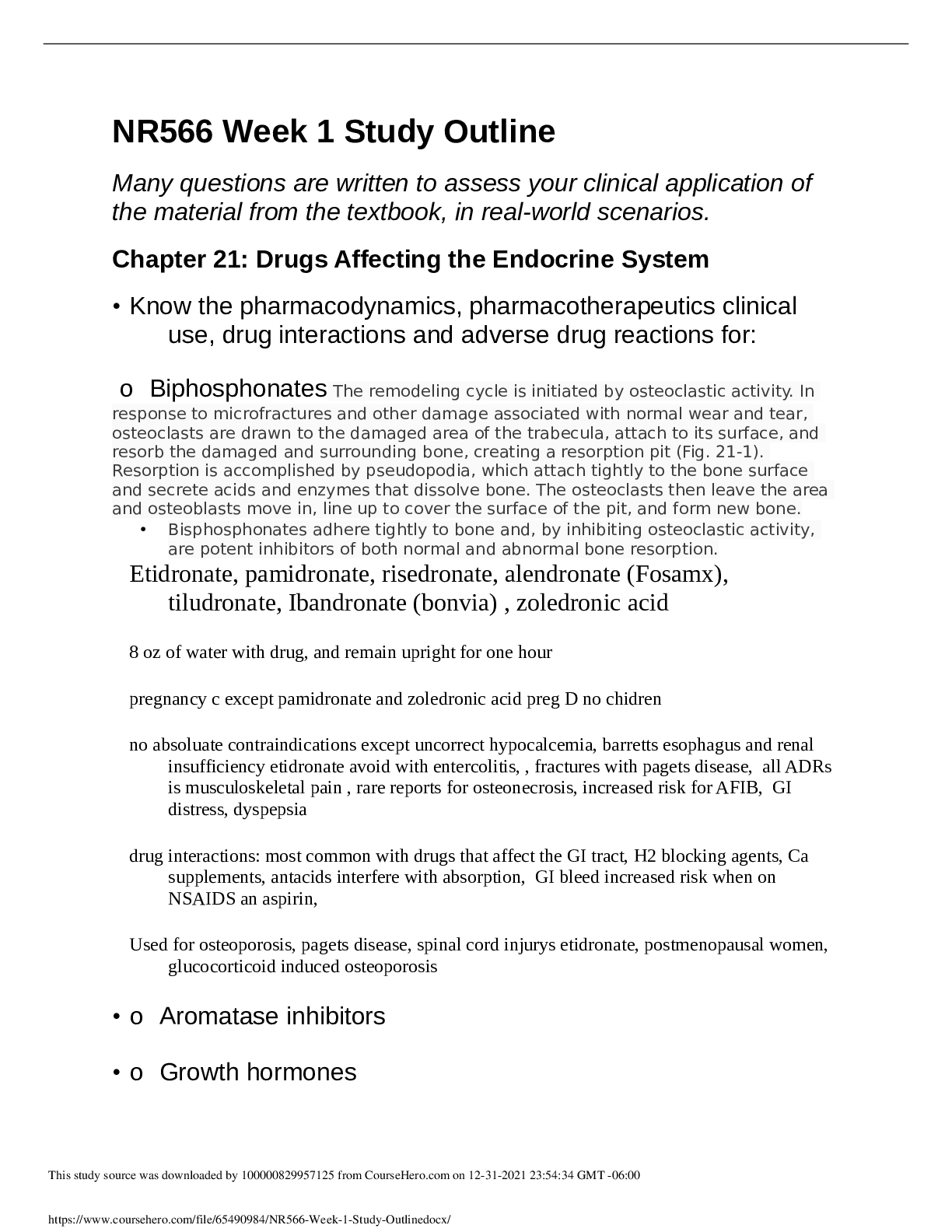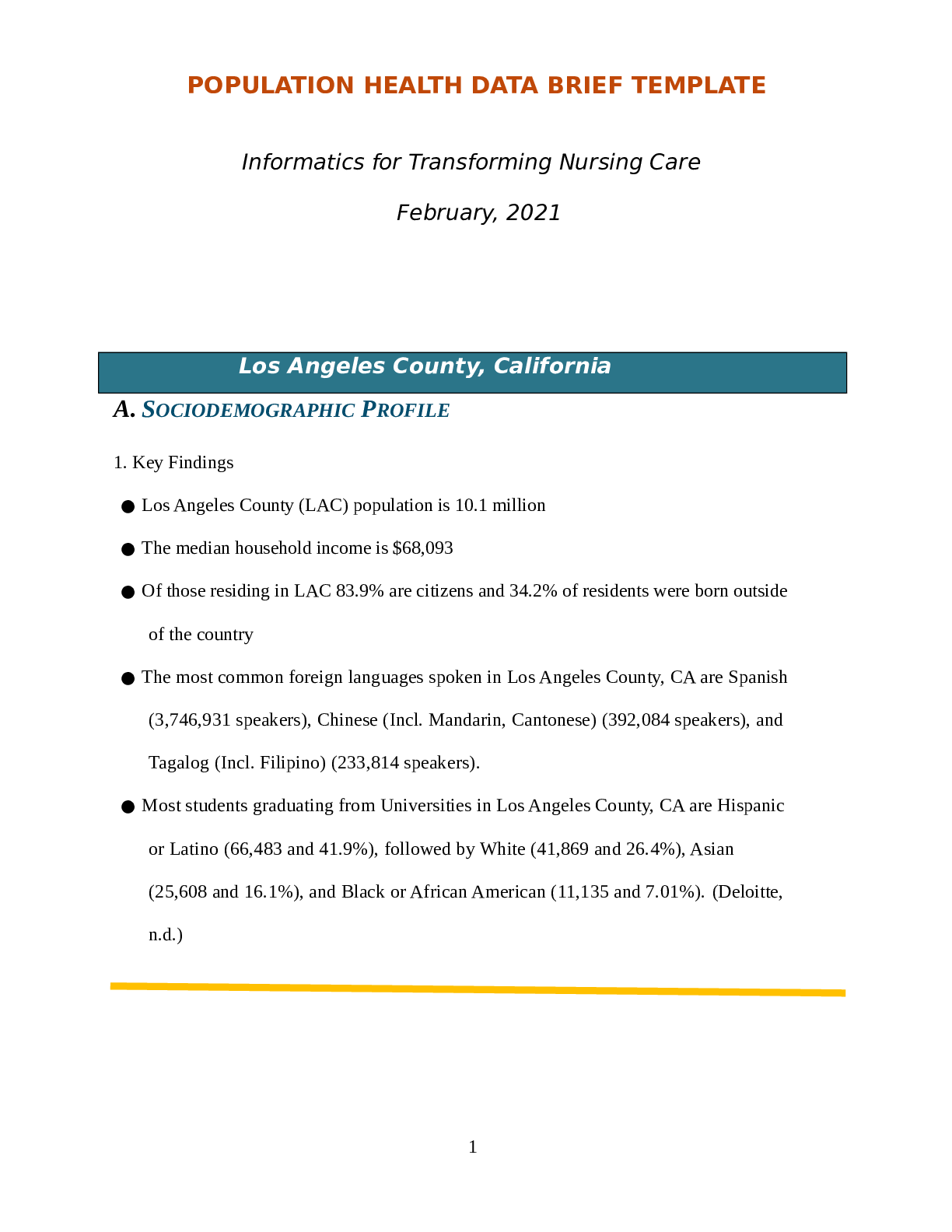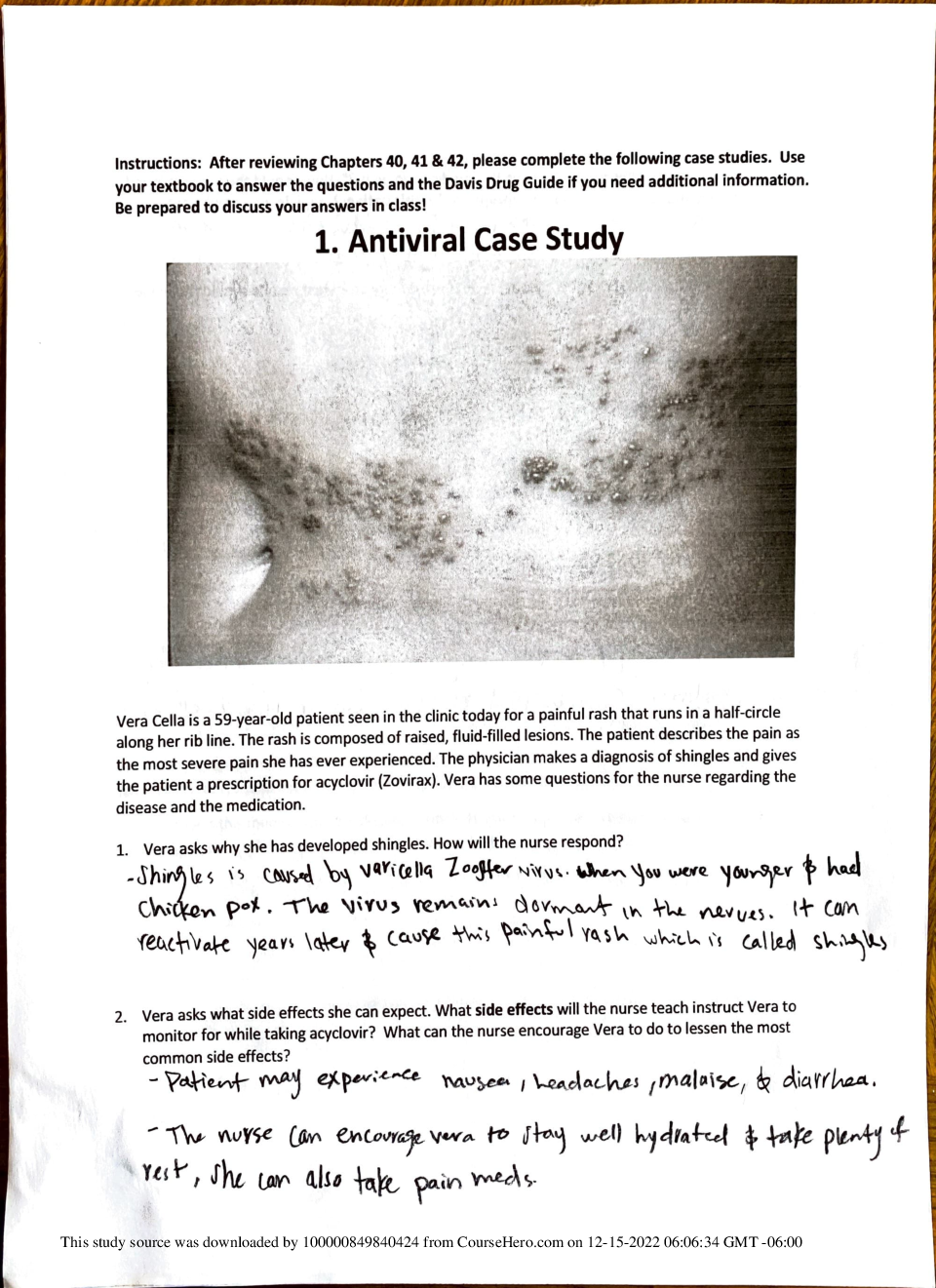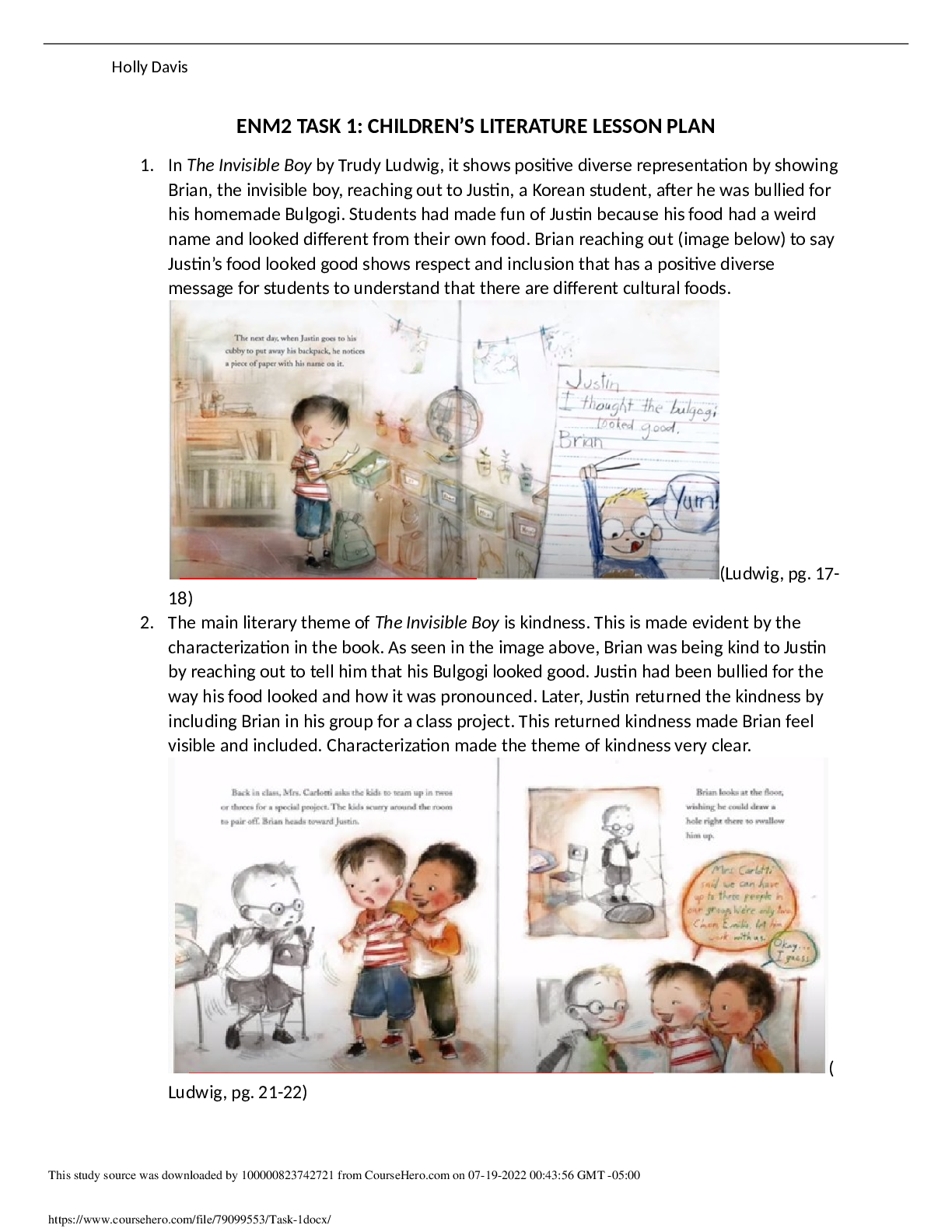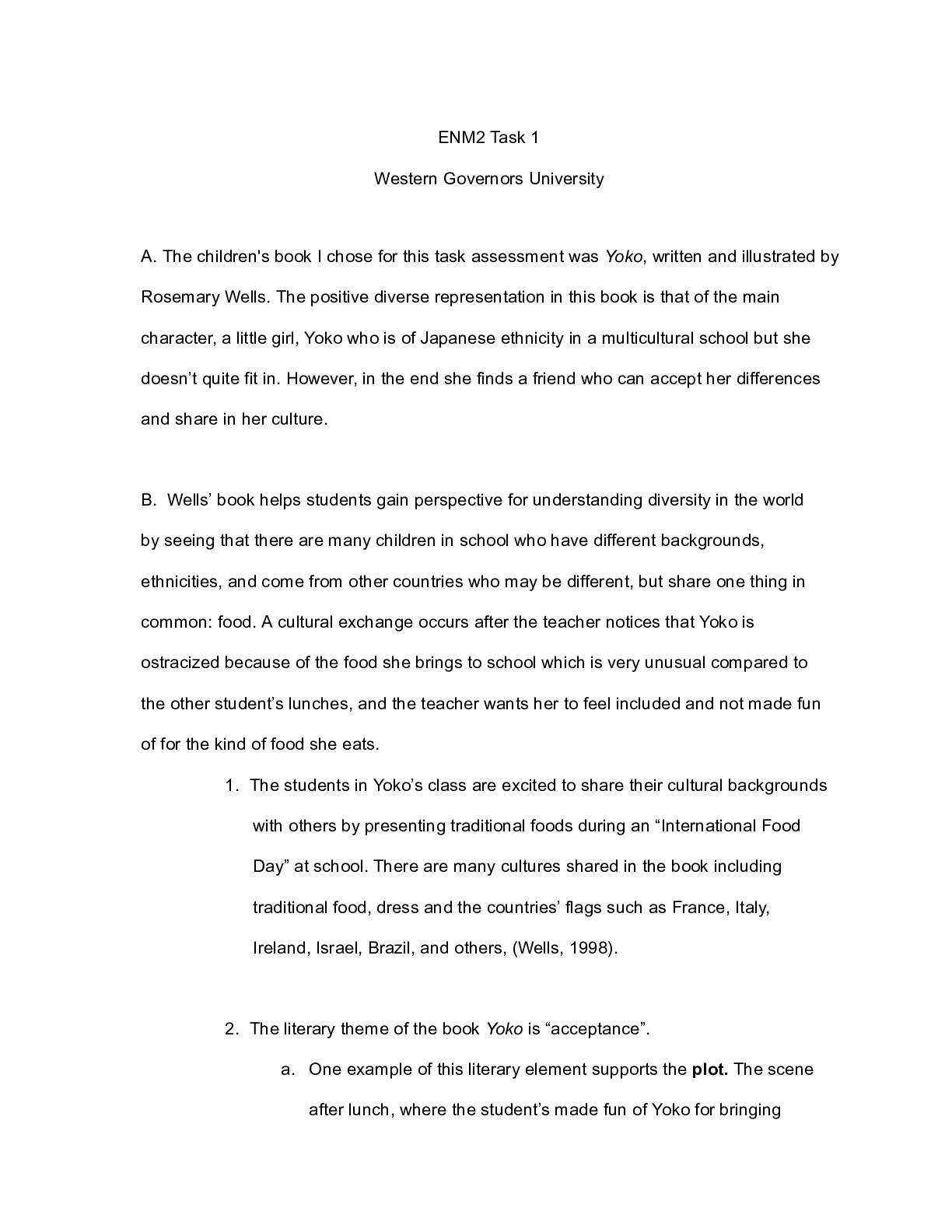Business > CASE STUDY > Children s Literature Lesson Plan 1.pdf ENM2 Task 1 Western Governors University A. T (GRADED) (All)
Children s Literature Lesson Plan 1.pdf ENM2 Task 1 Western Governors University A. T (GRADED)
Document Content and Description Below
ENM2 Task 1 Western Governors University A. The children's book I chose for this task assessment was Yoko, written and illustrated by Rosemary Wells. The positive diverse representation in thi... s book is that of the main character, a little girl, Yoko who is of Japanese ethnicity in a multicultural school but she doesn’t quite fit in. However, in the end she finds a friend who can accept her differences and share in her culture. B. Wells’ book helps students gain perspective for understanding diversity in the world by seeing that there are many children in school who have different backgrounds, ethnicities, and come from other countries who may be different, but share one thing in common: food. A cultural exchange occurs after the teacher notices that Yoko is ostracized because of the food she brings to school which is very unusual compared to the other student’s lunches, and the teacher wants her to feel included and not made fun of for the kind of food she eats. 1. The students in Yoko’s class are excited to share their cultural backgrounds with others by presenting traditional foods during an “International Food Day” at school. There are many cultures shared in the book including traditional food, dress and the countries’ flags such as France, Italy, Ireland, Israel, Brazil, and others, (Wells, 1998). 2. The literary theme of the book Yoko is “acceptance”. a. One example of this literary element supports the plot. The scene after lunch, where the student’s made fun of Yoko for bringing sushi. Afterwards during recess Yoko didn’t want to play, so the teacher asked her what was wrong. “Everybody laughed at my lunch,” answered Yoko. “They’ll forget about it by snack time,” said Mrs. Jenkins, (Wells, 1998). But they didn’t. (During snack time the students also made fun of Yoko’s snack). It was after this teasing that the teacher decided to teach a social skills lesson to the class by incorporating an International Food Day at school.The students were directed to try a bite of everything. It is inferred that if everyone brings a foreign dish, then Yoko won’t be the only one bringing something unusual, and that by trying all kinds of new foods, the other student’s might actually try and like the sushi. However, only one student did try it, liked it and became friends with Yoko after that. 3. It is important to select children’s literature that incorporates quality artwork, illustrations or images because the illustrations help to relate the information from the text in meaningful ways. The artistic mediums, techniques, and style also impact the reader by evoking emotions through the illustrations tone or mood (Galda, 2017). Books that have visually stimulating artwork can help to decode the words into instantly recognizable visual interpretation which will help encourage the reader to actively find visual clues to interpret the fundamental elements in the story, (Middleton, 2018). Quality imagery, especially in picturebooks, which are fundamental for the emergent reader, can further enhance the meaning of the story. Pictures or images in a book can help the reader hone in on details that words cannot express, according to Nodelman (1988), “words limit the illustrations by telling us what to pay attention to and how to interpret them”. 4. The picture from the book I chose conveys the theme of “acceptance” because Timothy is willing to try Yoko’s sushi, whereas none of the other student’s were willing to accept the cultural food. What is also conveyed is the way Timothy is trying to use chopsticks and is having difficulty then Yoko shows him how. This was not directly stated in words, but as stated earlier, the illustrations in a picturebook help tell more than the words alone can say. The illustrations in this book are drawn in an “Outline” style art which Rosemary Wells is well known for in all of her children’s books. 4. The genre of the book Yoko is that of a realistic fiction picturebook. a. Two characteristics of a picturebook are: (1) Picture books may or may not have words in them, but the words alone cannot convey the entire story. (2) The visual illustrations can provide the entire narrative without use of the written word. In other words, the illustrations along with the written word will unite and harmonize the story to fulfill the ultimate goal of “synergy”, (Sipe, 1998). This picturebook genre is that of realistic fiction. b. A characteristic that defines realistic fiction in this book is that the story helps to illuminate that there are social concerns and divides, even in the lower elementary grades as shown when some students make fun of Yoko for bringing sushi and red bean ice cream to school. “Realistic fiction is a story that the author reveals what could really happen in a particular time and place to particular people, (Galda, 2017). C. The following pages will show the lesson plan I have developed to help teach analyzing a literary theme. Direct Instruction Lesson Plan ENM2 — ENM2 TASK 1: CHILDREN’S LITERATURE — C970 General Information Lesson Title: Analyzing a literary theme Subject(s): ELA Grade/Level/Setting: 2nd grade, General Ed, whole group/small group/individual Prerequisite Skills/Prior Knowledge: The students should be able to sit and listen to a story, use an iPad to locate lesson plan activities on apps. Prior knowledge on story formations,fiction/nonfiction, main idea, and “beginning, middle, end” retelling of a story. Standards and Objectives TEKS 110.4 English Language Arts and Reading, Grade 2, Adopted 2017: (8) Multiple genres: listening, speaking, reading, writing, and thinking using multiple texts--literary elements. The student recognizes and analyzes literary elements within and across increasingly complex traditional, contemporary, classical, and diverse literary texts. The student is expected to: (A) discuss topics and determine theme using text evidence with adult assistance; Reference: TEA. (2017). Texas Essential Knowledge and Skills for Grade 2. Retrieved December 1, 2020 from https://tea.texas.gov/sites/default/files/Grade2_TEKS.pdf Learning Objective(s): Given a read-aloud book Yoko, by Margaret Wells, vocabulary, matching literary elements terms, and a small group activity, the student will be able to give a short answer video via Loom app to describe what the theme of the story is for Yoko and why using context clues with 100% accuracy. Materials Technology Teacher: Book: Yoko by Margaret Wells Computer/Whiteboard/overhead projector Digital Copy of: Narrative Story Board Organizer Paper and digital copies of: Teaching Theme In Literature Activities and Posters Theme Anchor Chart Webpage: BrainPOP jr. Webpage: Loom Webpage: Dictionary.com YouTube links: https://youtu.be/Jl4_o9Kb4RI , https://youtu.be/WjqiU5FgsYc Students: ELA Journal (composition book) Pencil/Colored pencils/crayons or markers Substitution- Using BrainPOP Jr. the students will be able to watch a video about Parts of Speech, includingTHEME, then take an interactive quiz which will substitute a paper quiz to assess understanding the concept. Augmentation- Utizing Dictionary.com to look up vocabulary words. Modification- Using the LOOM app, students will be able to RESPOND with short answers as a video of themselves answering the focus question. Redefinition- Students will use their iPads to be able to submit quizzes and create storyboard Scissors/glue stick Student iPads w/SeeSaw platform for assignments, Google Suite and Loom app downloaded. organizers electronically through assignments created on the SeeSaw platform by the teacher. Language Demands Language Function(s): Students will define and write the vocabulary words in their ELA Journal, use “Theme” anchor charts as a way to make visual connections to the lesson, and be able to identify the “theme” based on context clues in grade level fiction and nonfiction literature. Vocabulary: Theme- The big idea, or message the author is trying to express to their readers. Context Clues- information (such as a definition, synonym, antonym, or example) that appears near a word or phrase and offers direct or indirect suggestions about its meaning. Infer-deduce or conclude (information) from evidence and reasoning Synonym- one of two or more words or expressions of the same language that have the same or nearly the same meaning Antonym- a word opposite in meaning to another Explanation-a statement or account that makes something clear Example- a characteristic of its kind or illustration, something to be imitated. List of Common Themes in Stories: Courage Acceptance Cooperation Perseverance Responsibility Friendship Respect Kindness/Love Discourse and/or Syntax: Discourse: students will participate in small group discussions about the possible Theme of a given short story/fable. Syntax: students will utilize their ELA Journal to write their hypothesis of the theme to the story as well as write context clues and story analysis on the guided practice Theme Activity. Planned Language Supports: The small group discussion will allow for interaction between 3-4 students, using oral language to express their thoughts about the vocabulary terms and the most correct theme of the story. The teacher will monitor discussions by walking around the classroom observing and encouraging participation and answering any questions or redirecting the student’s when needed. Instructional Strategies and Learning Tasks Anticipatory Set: Activity Description/Teacher Student Actions -Ask students to get out their ELA journal and their pencil. -Draw a vertebrae on the board, then draw a heart next to it. Explain to the students you are going to talk about elements of a story. To flip to their previously learned information on the parts of a story. Discuss how the plot is like the backbone of the story—it’s made up of many pieces that fit together in a certain order. Without a plot, the entire story collapses. Theme, however, is the heart of the story.. It gives everything meaning, like the moral of the story. ● Seated at their desks, students will take out their ELA journals and a pencil when directed by the teacher. They should remain seated and facing the front, paying attention as the teacher instructs using the whiteboard/overhead projector. ● Students should raise their hands to answer any question or to participate. Presentation Procedures for New Information and/or Modeling: Activity Description/Teacher Student Actions -Ask students to assemble into their designated small groups. Ask students to get out their ELA Journals.Using the overhead projector, introduce the vocabulary words and write them on the board.While in their small groups they will look up the words in Dictionary.com and write the definitions in their journal. -Play the short clip on YouTube about how to find the THEME of a story. -Pass out paper copies of Teaching Theme In Literature Activities and Posters for students to cut and glue into their journals (on the next blank page). Discuss the many types of Themes that one can devise from stories. -Ask the students to listen to the story “Yoko” and when they are done,they will complete an activity paper together in small groups using the story for their answers. -Read the story “Yoko” by Rosemary Wells. ● Students should be prepared with the proper tools, including pencil and ELA journal. ● Students should properly utilize their scissors and glue when cutting and pasting. ● Students should keep the level of noise to a low level while working with each other to answer the vocabulary within their small groups. ● Students should not be talking or playing around with anything while the teacher is reading the book.Listening ears. Guided Practice: Activity Description/Teacher Student Actions -Assist students by going over the beginning, middle, and end of the story aloud, asking for student participation, raising hands to answer questions. Write the information on the board in a Narrative Story Board Organizer as we go along. - Utilize theTheme Anchor Chart that will help guide the students through what is a theme. - Hand out the Theme Activity paper. Tell students to fill in the blanks on the paper, answering any questions they may have and encouraging participation in their groups. -Then, ask them to draw a big heart in their ELA journal on the next blank page. Ask them to consider what the story “Yoko” seems to be about, not what happens in it, but what is the message and have them write their idea inside the heart. Ask them for evidence from the story. ● Students should listen to the teacher, participate in answering questions, asking questions if they don’t understand, and work together in small groups appropriately. Students should fill out their graphic organizer with well thought out answers. Independent Student Practice: Activity Description/Teacher Student Actions -Ask the students to go back to their original seats and put away their journals. -Ask them to get out their ipads after the above activity is complete. Have them go on to BrainPOP Jr. and watch the following video on THEME, then answer the questions independently. -Tell the students that they need to take a screenshot of the final grade from the quiz. Ask the students to come to the desk and show their grade. ● Students will go back to their original seats quickly and put away their supplies, get out their iPads and watch/listen to the short clip on BrainPOP Jr. with their headphones, and independently answer the questions at the end, taking a screenshot of the final grade and showing it to the teacher upon request. Culminating or Closing Procedure/Activity: Activity Description/Teacher Student Actions Once all grades have been submitted, ask students to put away all their supplies and Students should put away all personal articles have them turn off the lights and that they need to pay attention to this next movie. - Using “smartboard”, turn on Disney’s short movie, “The Present” and afterwards discuss the elements of the story and the THEME of the story with the - students. - Next, students will answer the Theme question “What is the theme of Disney’s movie, “The Present” and upload their video answer into the Loom app. then watch, listen and pay attention to the movie, being prepared to answer the Theme question asked by the teacher and upload their video answer into the Loom app. Differentiated Instruction Gifted and Talented: When given the vocabulary, utilize the vocabulary word in a sentence. When calling on a student in the GT program, structure any questions with a slightly increased difficulty level or more lengthy explanation. ELL: Group ELL students together during guided practice. If needed, the teacher can provide the content vocabulary in the students native language to assist in their learning of the new material. Teacher will check for understanding frequently. Students with Other Special Needs: Students with any special needs or learning disabilities will be provided the necessary accommodations as listed in their IEP, to include but not limited to: extra time, shortened assignments, check for understanding, picture vocabulary, speech to text, peer mentor, additional assistance as necessary. Assessment Formative During guided activity, teacher will check for understanding while walking around the groups and monitoring students, will also monitor progress of students' completion of the guided practice worksheet and vocabulary words. Summative The students will take a quiz at the end of watching the BrainPOP Jr. video on THEME. The students will take a screenshot and turn in that grade for a summative assessment grade. The students will also make a Loom video of themselves answering what the Theme of the Disney short video clip they watched at the end of the class. Resources BrainPOP Jr. (2020).Theme - BrainPOP Jr. Retrieved 11 December 2020, from https://jr.brainpop.com/readingandwriting/storyelements/theme/ Education.com. (2020). EL Support Lesson- Create Your Own Story. Retrieved 11 December 2020 from https://www.education.com/lesson-plan/el-support-lesson-create-your-own-story/ Galda, L., Liang, L.A., Cullinan, B.E. (2017). Literature and the Child, 9th Edition. (Western Governors University). Retrieved from https://wgu.vitalsource.com/#/books/9781305642362/ Middleton, E., & Says, N. (2018, June 19). The Importance of Illustration in Picture Books. Retrieved November 20, 2020, from https://emmamiddleton.com/2018/06/19/the-importance-of-illustration-in-picture-books/. Mitzel, T. (2016, Feb 7). Story Elements: Theme. Retrieved 11 December 2020 from https://youtu.be/Jl4_o9Kb4RI Nodelman, P. (1998). Words about pictures: The narrative art of children’s picture books. Athens: University of Georgia Press. Kraus, L. (2020). Teaching Theme Activities. Retrieved 11 December 2020 from https://www.teacherspayteachers.com/Product/Teaching-Theme-Activities-1583986?st=6 aad2378bf9189e75fd00229b114852b Sipe, L. R. (1998). Individual Literary Response Styles of First and Second Graders. In T. Shanahan and F.V. Rodriguez-Brown (Eds.), Forty-seventh yearbook of the National Reading Conference (pp. 76-89). Chicago: National Reading Conference. Studentreasures. (2019, October 4). Exploring Theme: 2 In-Depth Lesson Plans for 2nd Grade: Studentreasures Blog. Studentreasures Publishing. https://studentreasures.com/blog/exploring-theme-2-depth-lesson-plans-2nd-grade/. TEA. (2017). Texas Essential Knowledge and Skills for Grade 2. Retrieved December 1, 2020 from https://tea.texas.gov/sites/default/files/Grade2_TEKS.pdf Think Grow Giggle.(2020). Teaching Theme in Literature Activities and Posters. Retrieved 11 December 2020 from teacherspayteachers.com/Product/Teaching-Theme-In- Literature-Activities-and-Posters-2389440 [Show More]
Last updated: 1 year ago
Preview 1 out of 12 pages

Buy this document to get the full access instantly
Instant Download Access after purchase
Add to cartInstant download
We Accept:

Reviews( 0 )
$9.50
Document information
Connected school, study & course
About the document
Uploaded On
Jul 19, 2022
Number of pages
12
Written in
Additional information
This document has been written for:
Uploaded
Jul 19, 2022
Downloads
0
Views
39




